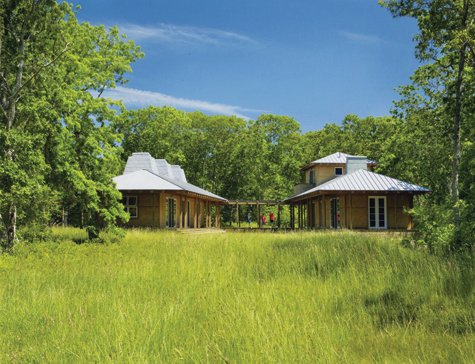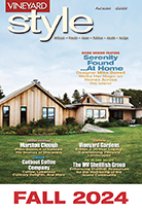HOME PORTRAIT

Contemporary Living on Martha's Vineyard
Profile by Anne McCarthy Strauss
In their book Martha’s Vineyard: Contemporary Living, Boston architects and authors Keith Moskow and Robert Linn dispense with the traditional notion of Martha’s Vineyard as a Victorian mecca dotted with gingerbread cottages and grey shingled homes. Although those houses do indeed exist here, Moskow and Linn take us on a tour of 25 new homes – each built within the last five years – that expand the Vineyard’s architectural footprint to include contemporary buildings that share the goal of gently breaking with tradition while meeting the challenges and taking advantage of the natural beauty of building on the island of Martha’s Vineyard.
Since its founding in Boston in 1990, Moskow Linn Architects, Inc. has been committed to environmentally sensitive architecture. The firm has designed custom residences, institutional buildings and master plans for future growth and strategic development in urban and rural areas. They have won scores of awards and commissions, perhaps most notably the Massachusetts Port Authority design competition for the $4 million 2-acre tribute to 9/11/2001 at Logan International Airport. No one here will forget that the two planes that took down the World Trade Center on that dreadful day took off from Logan.
Keith Moskow, AIA, the principal of the firm, received a Bachelor of Arts from Dartmouth College and a Masters of Architecture from the University of Pennsylvania. He has received design awards from the American Institute of Architects, The Boston Society of Architects, and the Municipal Arts Society of New York. Keith is the Commissioner of Professional Practice for the Boston Society of Architects and is the author of four books on architecture. He has been a lifelong summer resident of Martha’s Vineyard, where he and Linn have completed multiple architectural commissions. He is the author of The Houses of Martha’s Vineyard, Sustainable Facilities, and, with Linn, of Small Scale: Creative Solutions for Better City Living.
Robert Linn, a partner in the firm, received an undergraduate degree in architecture from the University of Arkansas and a Masters of Architecture from Harvard University. An accomplished designer and renderer, he has won awards from the American Society of Perspectivists, the American Institute of Architects, the Boston Society of Architects and a gold medal in the Seoul, Design Olympiad. Robert was a recipient of the Rotch Fellowship and is the author of two books on architecture.
The pair takes on every new project with the enthusiasm of a couple of kids with their first set of LEGOs. That roster of projects has grown to include the student and science centers for Chapel Hill-Chauncy Hall School in Waltham; the Maui Academy of Performing Arts; a boutique hotel in San Miguel, Mexico; a $200 million Boston high-rise home and luxury condominium development; a tannery complex and a conservation law foundation.
Martha’s Vineyard: Contemporary Living is the perfect companion book to Moscow’s 2005 The Houses of Martha’s Vineyard. It’s filled with ideas and visuals from some of today’s best contemporary home architects in the Northeast.
Twin Wings
Unlike Arbor House, which needed to be designed to warm its occupants through winter’s chill, the instructions to Moskow and Linn for the design of this Martha’s Vineyard home were that it would be used only during the summer months. However, it would be used by two separate families at a time, and ensuring their respective privacy was key.
Moskow and Linn devised an ingenious structure consisting of two distinct wings, one for sleeping and one for living, joined by covered walkways, and separated by a central lawn. And along that walkway there is that Vineyard staple, the outdoor shower, to be used after returning from the beach.
Both wings include a master bedroom for those occasions when only one wing of the house is occupied.
Typical of the work of Moskow and Linn, but unlike traditional Vineyard design, the home features clean straight lines. But the materials used to build the house are those that are generally used locally, right down to the white cedar shingles of the exterior. The roof is clad in lead-coated copper. Floors are made from fir, as are the exterior decks, exterior trim and ceilings, while the other millwork is maple. Stone for the counters and chimney is green slate. “We used low maintenance materials wherever possible so upkeep is easy,” Moskow said.
The design of the house takes advantage of the ocean breezes to cool the house during the hottest time of year. Super insulation between the roof and ceiling further minimize heat. Deep roof overhangs protect glass walls from the heat of the sun. For further cooling in the sleeping areas, each bedroom includes double doors that open onto wide porches and the cool central lawn. Small, high windows in each bedroom draw heat away.
Although there is a fireplace, it uses a Rumford-style firebox designed to better distribute heat than conventional hearths. The chimney and its surrounding stone floor are designed like a thermal flywheel that absorbs heat by day and re-radiates it when nights are cool.
Arbor House
Eco-Friendly Guest Quarters
A Arbor House is a guesthouse in Chilmark that was designed by the authors’ firm, Moskow Linn of Boston. Knowing that they wanted the guesthouse to be entirely heated and cooled without fossil fuels, the owners of the main house chose Moskow Linn Architects because of the firm’s commitment to environmentally sensitive architecture. As year-round visitors to the Island with year-round guests, the homeowners needed a four-season guesthouse.
Keith Moskow and his partner Robert Linn worked with environmental consultant Mark Kelley to design a passive solar guesthouse. The design and construction followed basic passive solar design principles, ensuring that the 800 square-foot building would keep guests warm even on the most bone-chilling Vineyard nights, and cool in the heat of summer.
The guesthouse was positioned along an east-west axis so that its windows would face south, allowing for maximum solar gain. The foundation is extremely well-insulated and thermal breaks were planned carefully. Taking special care to ensure even well-insulated footings ensured a high level of energy efficiency from the beginning of the project.
The architects kept to the solar designer's guideline of seven square feet of thermal mass for every square foot of south facing glazing. The sandwich of slate floor above and concrete sub-floor below provide the right combination to absorb scorching daytime heat and slowly release warmth in the cool of the evening.
This was a good start for warming the guest house, but not enough to guard completely against winter’s chill. So, two wood-burning stoves were incorporated into the design to serve as supplemental heat sources. The thermal mass ensures that guests will arrive at a home that isn’t freezing. Once inside, they can warm the house further with the wood-burning stoves. In another low-technology arrangement with high impact results, the team installed an inline duct fan. The fan re-circulates the heat that has risen to the ceiling back down to the floor for an additional warming effect. Conversely, during the summer, a fan pushes warm air that has risen to the ceiling out through the chimney.
Finally, a tankless hot-water heater provides warm water only when needed, rather than consuming energy 24 hours a day.
Since its founding in Boston in 1990, Moskow Linn Architects, Inc. has been committed to environmentally sensitive architecture. The firm has designed custom residences, institutional buildings and master plans for future growth and strategic development in urban and rural areas. They have won scores of awards and commissions, perhaps most notably the Massachusetts Port Authority design competition for the $4 million 2-acre tribute to 9/11/2001 at Logan International Airport. No one here will forget that the two planes that took down the World Trade Center on that dreadful day took off from Logan.
Keith Moskow, AIA, the principal of the firm, received a Bachelor of Arts from Dartmouth College and a Masters of Architecture from the University of Pennsylvania. He has received design awards from the American Institute of Architects, The Boston Society of Architects, and the Municipal Arts Society of New York. Keith is the Commissioner of Professional Practice for the Boston Society of Architects and is the author of four books on architecture. He has been a lifelong summer resident of Martha’s Vineyard, where he and Linn have completed multiple architectural commissions. He is the author of The Houses of Martha’s Vineyard, Sustainable Facilities, and, with Linn, of Small Scale: Creative Solutions for Better City Living.
Robert Linn, a partner in the firm, received an undergraduate degree in architecture from the University of Arkansas and a Masters of Architecture from Harvard University. An accomplished designer and renderer, he has won awards from the American Society of Perspectivists, the American Institute of Architects, the Boston Society of Architects and a gold medal in the Seoul, Design Olympiad. Robert was a recipient of the Rotch Fellowship and is the author of two books on architecture.
The pair takes on every new project with the enthusiasm of a couple of kids with their first set of LEGOs. That roster of projects has grown to include the student and science centers for Chapel Hill-Chauncy Hall School in Waltham; the Maui Academy of Performing Arts; a boutique hotel in San Miguel, Mexico; a $200 million Boston high-rise home and luxury condominium development; a tannery complex and a conservation law foundation.
Martha’s Vineyard: Contemporary Living is the perfect companion book to Moscow’s 2005 The Houses of Martha’s Vineyard. It’s filled with ideas and visuals from some of today’s best contemporary home architects in the Northeast.
Twin Wings
Unlike Arbor House, which needed to be designed to warm its occupants through winter’s chill, the instructions to Moskow and Linn for the design of this Martha’s Vineyard home were that it would be used only during the summer months. However, it would be used by two separate families at a time, and ensuring their respective privacy was key.
Moskow and Linn devised an ingenious structure consisting of two distinct wings, one for sleeping and one for living, joined by covered walkways, and separated by a central lawn. And along that walkway there is that Vineyard staple, the outdoor shower, to be used after returning from the beach.
Both wings include a master bedroom for those occasions when only one wing of the house is occupied.
Typical of the work of Moskow and Linn, but unlike traditional Vineyard design, the home features clean straight lines. But the materials used to build the house are those that are generally used locally, right down to the white cedar shingles of the exterior. The roof is clad in lead-coated copper. Floors are made from fir, as are the exterior decks, exterior trim and ceilings, while the other millwork is maple. Stone for the counters and chimney is green slate. “We used low maintenance materials wherever possible so upkeep is easy,” Moskow said.
The design of the house takes advantage of the ocean breezes to cool the house during the hottest time of year. Super insulation between the roof and ceiling further minimize heat. Deep roof overhangs protect glass walls from the heat of the sun. For further cooling in the sleeping areas, each bedroom includes double doors that open onto wide porches and the cool central lawn. Small, high windows in each bedroom draw heat away.
Although there is a fireplace, it uses a Rumford-style firebox designed to better distribute heat than conventional hearths. The chimney and its surrounding stone floor are designed like a thermal flywheel that absorbs heat by day and re-radiates it when nights are cool.
Arbor House
Eco-Friendly Guest Quarters
A Arbor House is a guesthouse in Chilmark that was designed by the authors’ firm, Moskow Linn of Boston. Knowing that they wanted the guesthouse to be entirely heated and cooled without fossil fuels, the owners of the main house chose Moskow Linn Architects because of the firm’s commitment to environmentally sensitive architecture. As year-round visitors to the Island with year-round guests, the homeowners needed a four-season guesthouse.
Keith Moskow and his partner Robert Linn worked with environmental consultant Mark Kelley to design a passive solar guesthouse. The design and construction followed basic passive solar design principles, ensuring that the 800 square-foot building would keep guests warm even on the most bone-chilling Vineyard nights, and cool in the heat of summer.
The guesthouse was positioned along an east-west axis so that its windows would face south, allowing for maximum solar gain. The foundation is extremely well-insulated and thermal breaks were planned carefully. Taking special care to ensure even well-insulated footings ensured a high level of energy efficiency from the beginning of the project.
The architects kept to the solar designer's guideline of seven square feet of thermal mass for every square foot of south facing glazing. The sandwich of slate floor above and concrete sub-floor below provide the right combination to absorb scorching daytime heat and slowly release warmth in the cool of the evening.
This was a good start for warming the guest house, but not enough to guard completely against winter’s chill. So, two wood-burning stoves were incorporated into the design to serve as supplemental heat sources. The thermal mass ensures that guests will arrive at a home that isn’t freezing. Once inside, they can warm the house further with the wood-burning stoves. In another low-technology arrangement with high impact results, the team installed an inline duct fan. The fan re-circulates the heat that has risen to the ceiling back down to the floor for an additional warming effect. Conversely, during the summer, a fan pushes warm air that has risen to the ceiling out through the chimney.
Finally, a tankless hot-water heater provides warm water only when needed, rather than consuming energy 24 hours a day.








